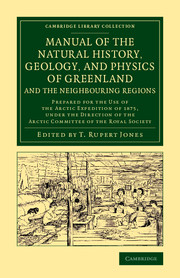Refine search
Actions for selected content:
12661 results in History of science
7 - No. 1 Propeller Company
-
- Book:
- Reinventing the Propeller
- Published online:
- 20 April 2017
- Print publication:
- 24 March 2017, pp 180-203
-
- Chapter
- Export citation
2 - “The Best Propeller for Starting Is Not the Best for Flying”
-
- Book:
- Reinventing the Propeller
- Published online:
- 20 April 2017
- Print publication:
- 24 March 2017, pp 16-44
-
- Chapter
- Export citation
Contents
-
- Book:
- From Traders to Innovators
- Published by:
- ISEAS–Yusof Ishak Institute
- Published online:
- 19 May 2017
- Print publication:
- 27 October 2016, pp v-vi
-
- Chapter
- Export citation
Bibliography
-
- Book:
- From Traders to Innovators
- Published by:
- ISEAS–Yusof Ishak Institute
- Published online:
- 19 May 2017
- Print publication:
- 27 October 2016, pp 213-222
-
- Chapter
- Export citation
About the Author
-
- Book:
- From Traders to Innovators
- Published by:
- ISEAS–Yusof Ishak Institute
- Published online:
- 19 May 2017
- Print publication:
- 27 October 2016, pp 232-232
-
- Chapter
- Export citation
List of Abbreviations
-
- Book:
- From Traders to Innovators
- Published by:
- ISEAS–Yusof Ishak Institute
- Published online:
- 19 May 2017
- Print publication:
- 27 October 2016, pp vii-x
-
- Chapter
- Export citation
1 - From Dependency Theory to Creative Innovation
-
- Book:
- From Traders to Innovators
- Published by:
- ISEAS–Yusof Ishak Institute
- Published online:
- 19 May 2017
- Print publication:
- 27 October 2016, pp 1-27
-
- Chapter
- Export citation
Index
-
- Book:
- From Traders to Innovators
- Published by:
- ISEAS–Yusof Ishak Institute
- Published online:
- 19 May 2017
- Print publication:
- 27 October 2016, pp 223-231
-
- Chapter
- Export citation
5 - Nurturing a Scientific Culture
-
- Book:
- From Traders to Innovators
- Published by:
- ISEAS–Yusof Ishak Institute
- Published online:
- 19 May 2017
- Print publication:
- 27 October 2016, pp 110-139
-
- Chapter
- Export citation
7 - Towards a Technologically Creative Society
-
- Book:
- From Traders to Innovators
- Published by:
- ISEAS–Yusof Ishak Institute
- Published online:
- 19 May 2017
- Print publication:
- 27 October 2016, pp 168-195
-
- Chapter
- Export citation
Introduction
-
- Book:
- From Traders to Innovators
- Published by:
- ISEAS–Yusof Ishak Institute
- Published online:
- 19 May 2017
- Print publication:
- 27 October 2016, pp xi-xx
-
- Chapter
- Export citation
3 - Developing a Technological Growth Trajectory in the 1980s
-
- Book:
- From Traders to Innovators
- Published by:
- ISEAS–Yusof Ishak Institute
- Published online:
- 19 May 2017
- Print publication:
- 27 October 2016, pp 51-85
-
- Chapter
- Export citation
6 - Sociocultural Attributes and R&D
-
- Book:
- From Traders to Innovators
- Published by:
- ISEAS–Yusof Ishak Institute
- Published online:
- 19 May 2017
- Print publication:
- 27 October 2016, pp 140-167
-
- Chapter
- Export citation
Frontmatter
-
- Book:
- From Traders to Innovators
- Published by:
- ISEAS–Yusof Ishak Institute
- Published online:
- 19 May 2017
- Print publication:
- 27 October 2016, pp i-iv
-
- Chapter
- Export citation
2 - Surviving and Catching Up in the 1960s and 1970s
-
- Book:
- From Traders to Innovators
- Published by:
- ISEAS–Yusof Ishak Institute
- Published online:
- 19 May 2017
- Print publication:
- 27 October 2016, pp 28-50
-
- Chapter
- Export citation
8 - Conclusion: Power of a Service-Brokerage Culture
-
- Book:
- From Traders to Innovators
- Published by:
- ISEAS–Yusof Ishak Institute
- Published online:
- 19 May 2017
- Print publication:
- 27 October 2016, pp 196-212
-
- Chapter
- Export citation
4 - State Intervention and Technological Change
-
- Book:
- From Traders to Innovators
- Published by:
- ISEAS–Yusof Ishak Institute
- Published online:
- 19 May 2017
- Print publication:
- 27 October 2016, pp 86-109
-
- Chapter
- Export citation

The Cambridge Companion to Newton
-
- Published online:
- 05 July 2016
- Print publication:
- 29 March 2016

Manual of the Natural History, Geology, and Physics of Greenland and the Neighbouring Regions
- Prepared for the Use of the Arctic Expedition of 1875, under the Direction of the Arctic Committee of the Royal Society
-
- Published online:
- 05 June 2016
- Print publication:
- 25 September 2014
- First published in:
- 1875

An Historical and Descriptive Account of the Steam Engine
- Comprising a General View of the Various Modes of Employing Elastic Vapour as a Prime Mover in Mechanics
-
- Published online:
- 05 June 2016
- Print publication:
- 25 September 2014
- First published in:
- 1822
